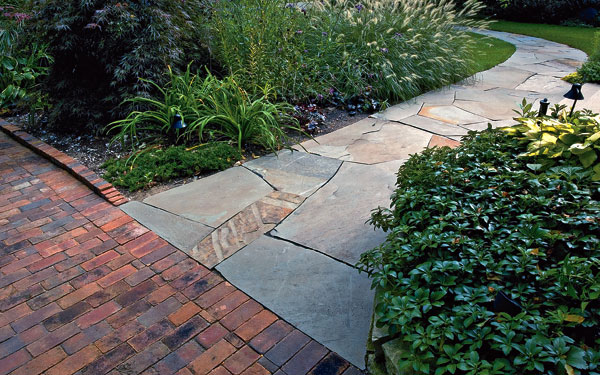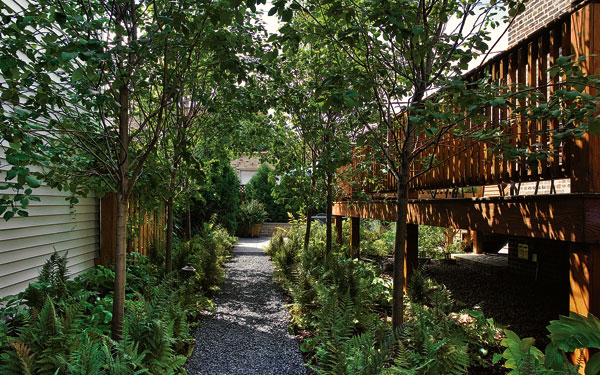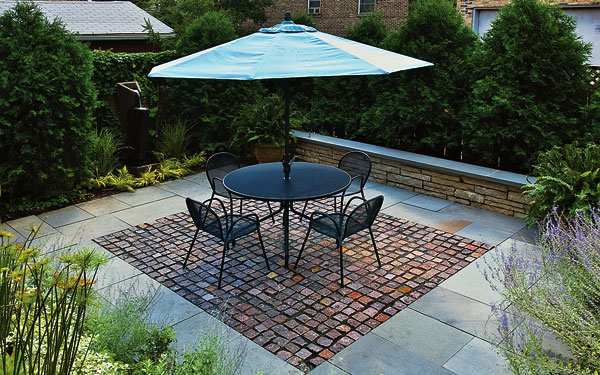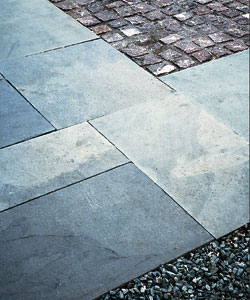 |
|
Krugel Cobbles’ masons used irregular shapes, jagged edges, and a mix of bluestone’s color tones to take the formality down a notch in this Oak Park garden. |
Like a rug that defines the sofa-and-conversation area of a wide-open loft apartment, a nicely done garden carpet can suggest walls where there are none and create intimacy within a larger space. That’s true whether it’s delineating an outdoor dining area or connecting, hallway-like, one part of the garden to another. Even though it’s going to get walked on, the garden carpet should be anything but pedestrian.
|
|
"You set a lot of the mood of your garden with paths, and the material you use for them projects an image," says Tiffany Evans, a landscape designer and director of the residential team at Douglas Hoerr Landscape Architecture. And just as interiors have gone eclectic, pulling together great pieces from assorted eras and styles, garden flooring can mix materials with great results. The trend is called "quilting," says Jon Hirsch, vice-president of Krugel Cobbles, a Lake Bluff-based firm that specializes in hard surfaces. Combining two types of stone or cutting one type of stone two or more ways (rectangles spliced together with more organic shapes, for example, ) gives a little extra visual twist to an otherwise overlooked aspect of the garden. Either way, quilting is for those who are tired of the proper bluestone path but don’t intend to forsake the material entirely. Or their garden’s mood changes at some point between front yard and back, and they want the paving to reflect that fluid transition.
Evans says bluestone is a great candidate for quilting. It’s like a black sweater: We love them, but we’ve seen way too many of them. So what can you do to give it a new spin? "You don’t have to have [rectilinear] slabs," she says. "You have it cut and laid in a pattern that looks more handcrafted."
|
|
Consider juxtaposing other materials, as well as other shapes and colors, to multiply the possibilities. Bluestone mixes nicely with brick, for example-try bluestone for seating and walking areas, with brick frames around them. Or separate spaces paved in bluestone (for relaxing) and brick (for cooking), with an artful mingling of the two where they connect.
For a small garden in Ukrainian Village, David Migdal of The Garden Consultants quilted together a dramatic combination of paths and rooms using crushed bluestone, traditional rectilinear bluestone slabs, and richly textured granite blocks salvaged from the previous garden. In a narrow passageway along the side of the house, he laid down the outdoor equivalent of a hallway runner-a beeline path along an allée of serviceberry trees.
|
|
Lined with crushed bluestone, the path is "a variation on the material used for the entry walk to the house, but it’s more informal here," Migdal says. The crunching of the stone chips underfoot provides an irresistible, quintessential garden sound.The path delivers you to a handsome outdoor dining space (see photo at left), its floor continuing with the bluestone, with big rectilinear slabs framing a square "area rug" laid with those salvaged granite blocks. The granite’s knobby texture contrasts with the sleekness of the bluestone. The surface invites feet to play over it as much as a deep shag carpet would.Quilting is also a way to bring favorite materials from your interior outside. The tumbled marble of an entry hall can spill out to the front walk, where it gradually gives way to more garden-style jagged-edged limestone slabs. Even some remnants of that dramatic granite you ordered for custom countertops might look smart mixed with another material in an outdoor walk, Hirsch suggests-"You just want to hint at what’s inside."
Photography: Linda Oyama Bryan





